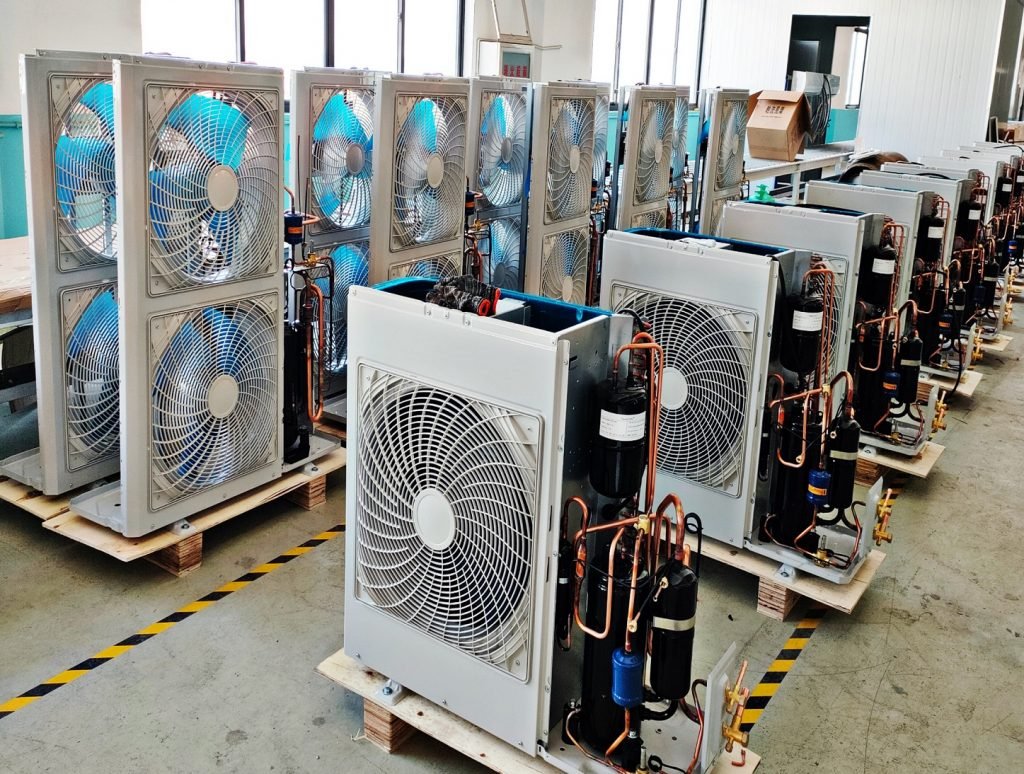Le système de réfrigération est un système de cycle complexe composé de composants clés tels que compresseur, condenseur, Soupape de détente, et évaporateur. Ces composants travaillent ensemble pour réaliser le refroidissement par la circulation du réfrigérant.
Cependant, Lorsque l'air entre dans ce système fermé, il peut entraîner des problèmes de série qui affectent son fonctionnement normal. Donc, il est crucial de comprendre les causes, distribution, dangers, et méthodes d'élimination de l'intrusion de l'air dans les systèmes de réfrigération.
Causes d'air dans le système de réfrigération
Bien que systèmes de réfrigération sont des cycles scellés où l'air ne doit pas entrer, l'air peut encore s'infiltrer pour diverses raisons.
Vous trouverez ci-dessous une analyse détaillée de ces causes:
1.Aspirateur incomplet pendant l'installation ou la maintenance
–L'aspirateur est essentiel pour éliminer l'air et l'humidité pendant l'installation ou l'entretien. Mauvaise performance de pompe à vide ou un temps d'aspiration insuffisant peut laisser de l'air dans le système.
–Les opérateurs ou les problèmes d'équipement inexpérimentés peuvent également entraîner un aspirateur incomplet.
2. Air introduit lors de l'ajout de réfrigérant
–Procédures incorrectes, tels que des conteneurs de réfrigérant non scellés ou des tuyaux à tort incorrectement connectés, peut permettre à l'air d'entrer dans le système pendant réfrigérant ajout.
–Les méthodes de remplissage ouvertes augmentent la probabilité que de l'air entre.
3. Fuite du système
–Les points de fuite dans le système peuvent laisser entrer l'air, en particulier si les deux & Les côtés de basse pression ont des fuites. Les différences de pression facilitent l'intrusion de l'air.
–Les fuites se produisent souvent aux connexions du tuyau, joints de soupape, ou sceaux de compresseur.
4. Utilisez des réfrigérants de qualité inférieure ou des conteneurs non scellés
–Les réfrigérants de qualité inférieure peuvent contenir des impuretés ou de l'humidité, introduire de l'air dans le système.
–Les conteneurs mal scellés permettent à l'air de mélanger avec réfrigérants et entrez par la suite le système.
5. Manque d'élimination de l'air pendant le fonctionnement à long terme
–Au fil du temps, l'air peut lentement infiltrer le système, en particulier avec des fluctuations de pression importantes.
–La négligence de l'opérateur ou l'équipement d'élimination de l'air défectueux peut entraîner une accumulation d'air.
6. Pénétration de l'air atmosphérique
Si le système’S La pression de fonctionnement est inférieure à la pression atmosphérique, l'air peut s'infiltrer dans le système par des lacunes dans les vannes, compresseurs, ou connexions non soudées.
7. Décomposition de l'huile lubrifiante
Quelques huiles lubrifiantes, comme les huiles minérales, peut se décomposer dans des conditions de travail complexes, libérer des hydrocarbures qui se mélangent avec le réfrigérant.
Distribution de l'air dans le système de réfrigération
1. Emplacements d'accumulation naturels
L'air est plus léger que réfrigérants et a tendance à s'accumuler à des points élevés du système, tel que:
Condenseur: Souvent installé à une position élevée dans le système, en faisant un point d'accumulation d'air commun.
Récepteur: Un autre point culminant où l'air se rassemble facilement.
Accumulateur: Certains systèmes voient l'air s'accumuler ici.
Sections élevées de tuyaux: Toute section de tuyaux surélevé peut devenir un emplacement pour l'accumulation d'air.
2. Mouvement de l'air dans le système
L'air peut se dissoudre dans le réfrigérant et se déplacer dans le système pendant le fonctionnement, affecter divers composants.
3. Impact de la conception du système sur la distribution de l'air
—Disposages de tuyaux complexes: Augmenter les zones potentielles pour l'accumulation d'air.
—Différences de hauteur: De grandes variations de hauteur dans le système peuvent entraîner un air concentré à des points plus élevés.
Dangers de l'air dans le système de réfrigération
1. Augmenter la consommation d'énergie
L'air se compose principalement d'azote et d'oxygène, qui sont des gaz non condensables. L'accumulation d'air dans le côté haute pression augmente la pression du système, forcer le compresseur travailler plus dur, Augmenter la consommation d'énergie et l'usure, et raccourcir le compresseur’S de la vie.
2. Induire des réactions chimiques
L'humidité dans l'air peut réagir avec réfrigérants, Surtout dans les systèmes d'huile minérale, produisant des substances acides qui corrodent les composants métalliques internes, entraînant des fuites et des dégâts.
3. Réduire l'efficacité de refroidissement
L'air dans le condenseur ou l'évaporateur peut provoquer « écluses à air, » obstruction à l'écoulement du réfrigérant et à l'échange de chaleur, réduire l'efficacité globale du système.
4. Former un bloc de glace
L'humidité dans l'air peut se congeler sur les dispositifs de limitation (par exemple., vannes d'expansion), provoquant des blocages qui perturbent réfrigérant débit et peut endommager l'équipement.
5. Altérer les performances de la valve d'expansion
La présence d'air peut déformer les lectures de pression à la soupape d'expansion, conduire à une réglementation inappropriée et à un débit de réfrigérant instable.
6. Problèmes de lubrification du compresseur
L'humidité dans l'air peut se dégrader huile de graissage, réduire son efficacité et provoquer compresseur usure ou échec.
Méthodes pour éliminer l'air du système de réfrigération
1. Utilisez des mécanismes de libération d'air conçus par le système
Beaucoup systèmes de réfrigération avoir des dispositifs de ventilation automatiques, comme les vannes de ventilation situées en haut du condenseur. Ces appareils peuvent expulser automatiquement l'air pendant le fonctionnement du système. Pour utiliser ces appareils pour la ventilation:
Localiser les vannes de décharge d'air: Souvent sur le condenseur’s point le plus élevé.
Libération manuelle: Ouvrez lentement la valve pendant le fonctionnement pour libérer de l'air tout en surveillant réfrigérant perte.
2. Méthode d'extraction sous vide
Utiliser la pompe à vide pour évacuer le système peut éliminer efficacement l'air et l'humidité.
Préparer la pompe à vide: Sélectionnez une pompe à vide adaptée au système’S Capacité et assurer qu'elle est en bon état de fonctionnement.
Connectez la pompe à vide: Fixez la pompe à vide au système’s vide.
Processus d'évacuation: Démarrez la pompe à vide et continuez à évacuation jusqu'à ce que la pression du système atteigne le niveau de vide spécifié. Il est généralement nécessaire de maintenir ce niveau pendant un certain temps afin d'assurer un retrait approfondi de l'air et de l'humidité.
Vérifiez le niveau de vide: Utilisez une jauge à vide pour surveiller le niveau de vide et assurez-vous qu'il répond aux exigences techniques.
3. Libération de l'air manuel
Lorsque le système est dans un état d'arrêt, Ouvrez manuellement la soupape de ventilation pour libérer de l'air.
Localiser la vanne d'évent: Identifiez la vanne d'évent dans le système, normalement situé au point culminant.
Ouvrez lentement la valve: Ouvrez progressivement la soupape de ventilation pour libérer de l'air. Surveillez le débit de réfrigérant pour éviter une perte de réfrigérant significative.
Ventilation répétée: Fait plusieurs opérations de ventilation jusqu'à ce qu'aucune bulle n'apparaît.
4. Libération d'air à haute température
En augmentant le système température, L'humidité dans l'air s'évapore, Et puis l'air est expulsé.
Chauffer le système: Utilisez un équipement de chauffage pour augmenter la température du système, provoquant l'évaporation de l'humidité.
Évacuer l'air: Dans des conditions à haute température, Expulsez de l'air et de la vapeur d'eau à travers la vanne de ventilation.
Refroidir le système: Après que le système se refroidit, Vérifiez tous les airs restants.
5. Utiliser des dessiccants
Ajouter des dessiccants au système pour absorber l'humidité et réduire l'impact de l'air.
Sélectionnez le dessicant: Utilisez des dessiccants adaptés à type de réfrigérant, comme les tamis moléculaires.
Installer le sèche-linge: Installer un séchoir dans le système et remplacer régulièrement le dessiccant.
6. Mesures préventives
Vérifiez régulièrement les fuites: Inspectez périodiquement le système’scel pour empêcher la pénétration d'air.
Ajouter correctement le réfrigérant: Lors de l'ajout de réfrigérant, Assurez-vous que le récipient est scellé pour éviter le mélange d'air.
Maintenir l'intégrité de l'étanchéité: Pendant la maintenance et l'installation, Assurez-vous que toutes les connexions sont correctement scellées.
7. Précautions de sécurité et d'environnement
Porter un équipement de protection: Pendant les opérations de ventilation, Portez des gants et des lunettes de protection pour éviter les brûlures à froid réfrigérant.
Empêcher les fuites de réfrigérant: Adhérer aux réglementations environnementales pour empêcher les fuites de réfrigérant qui pourraient nuire à l'environnement.
Utiliser des outils professionnels: Assurer l'utilisation des outils et équipements appropriés pour les opérations de ventilation.
8. Vérifiez l'efficacité de la ventilation
Test de pression: Surveillez la pression du système à l'aide d'un manomètre pour assurer la stabilité.
Observer l'état de fonctionnement: Après le fonctionnement du système, Observez l'effet de refroidissement et les performances du compresseur pour assurer aucune anomalie.
9. Problèmes communs
Le système ne fait toujours pas refroidir: Cela peut indiquer de l'air résiduel ou d'autres défauts, exiger du réinvention ou du dépannage supplémentaire.
Anomalies de pression: Vérifiez les fuites du système ou la défaillance dessicants.
Conclusion
Aérer une entrée dans systèmes de réfrigération est un problème important qui ne peut pas être ignoré, car il affecte non seulement l'efficacité du système, mais peut également raccourcir la durée de vie de l'équipement. L'air peut entrer dans le système pendant l'installation, entretien, fuites, ou charge de réfrigérant, s'accumulant principalement dans des zones élevées telles que les condenseurs ou près vannes d'expansion. Cela conduit à une efficacité réduite, dommages causés par le compresseur, blocages, et les déséquilibres de pression.
Pour résoudre ce problème, Cet article présente diverses méthodes pour éliminer l'air, y compris l'utilisation du système’S vannes de ventilation, ventilation manuelle, ventilation de vide, ventilation à haute température, et utiliser des dessiccants pour absorber l'humidité. En outre, Mesures préventives telles que les contrôles de fuite réguliers, Charge de réfrigérant appropriée, et le maintien de l'étanchéité du système sont cruciaux.
En résumé, Retirer en temps opportun de l'air du système est essentiel pour maintenir un fonctionnement efficace et prolonger la durée de vie de l'équipement. Tandis que plusieurs méthodes sont disponibles pour l'élimination de l'air, La prévention reste la clé. Grâce à une maintenance régulière et à des pratiques d'installation appropriées, peut assurer le fonctionnement en douceur du système.
Pour les opérateurs système, La vigilance contre la pénétration de l'air et la prise de mesures appropriées sont essentielles pour garantir le fonctionnement stable à long terme des systèmes de réfrigération. Ces méthodes et mesures préventives améliorent non seulement l'efficacité, mais économisent également sur les coûts de maintenance à long terme.
Tout commentaire?
Bienvenue laisser un message ou reposter.













